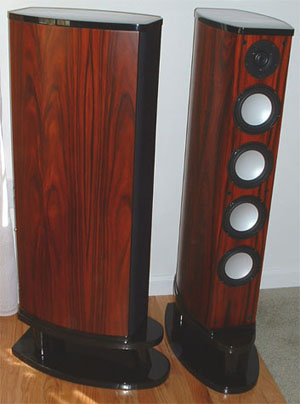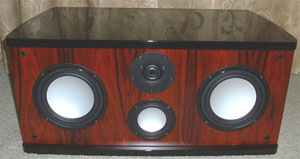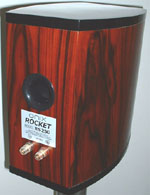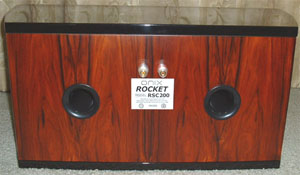Introduction
Rocket by Onix is a relatively new brand in the audio
world. However, the man behind the Rocket, Mark Schifter, has had more than
a three-decade-long career in the audio industry. This very credential can assure you that his products should be taken seriously.
Coupled
with the fact that he is proud of his Rocket line, one should
immediately sense that there must be something special about the Rocket
speakers, which he created in partnership with Mr. H. H. Pu, an industry
veteran from Taiwan. Now, how do I know that Mark is so proud of the
Rockets? Well, for those of you who don't know, Mark is active in several
audio online forums and easily accessible by e-mail. It was from his comments
in those forums and from some personal exchanges that I knew Rocket is his
beloved baby.
Mark markets the Rocket speakers, as well as his other products,
internet-direct only through his company, AV123.com. This is done in order
to avoid the overhead for selling products through local dealerships so that
the products can be offered to customers at cost/performance values.
For this to work,
the company has to have a strong customer service. Judging from the many
comments of the satisfied customers on the Internet and my own experience, I
can safely say that the AV123 customer service is nothing short of
excellent. While some would prefer to audition a product at a dealer's
showroom, few would argue that the best place to audition speakers is at
home. Therefore, selling speakers direct
actually makes a lot of sense, and AV123 backs this up with a 30 day return
policy, no questions asked. So, in case you don't like them, in the
worst-case scenario, what you lose is only the freight cost.
The Rocket speakers reviewed here are offered as the Home Theater
Package # 1 in the AV123 website, with a pair of RS750 floor-standing speakers
($1,399/Pair), RSC200 center channel ($599), and a pair of RS250 bookshelf
speakers ($699/Pair). The package is priced at $2,199, much cheaper than if you
buy those speakers separately. Also included in the review set was a pair of
optional risers ($99/Pair) for the RS750 speakers.
Features and Build Quality
Although the shipping package does not affect the
performance of a product in any way, nevertheless it sometimes reflects how
a company prizes its own products and in a way, it also shows how the
company appreciates its customers. And, I bet, customers like to have the feeling of being
appreciated by the company who gets their business. I would consider the
Rocket packaging to be exceptional. All speakers came double-boxed and
wrapped in white cloth bags (not plastic bags as is customarily done). These
cloths actually can also function as dust covers when the speakers are not
going to be used for a long time. Thoughtful! As if that were not enough, a
pair of white gloves is provided in each box, so you can handle the
speakers without leaving fingerprints on them. I personally felt that I received royal treatment with all this special care.
(It is probably also part of a Pacific Rim thing, where even the taxi
drivers wear white gloves.)
 The
special care in packaging would mean nothing, however, if the speakers
inside these packages were not up to par. Fortunately, the Rockets live up
to the nice packaging. First of
all, these speakers are things of beauty, which should get a high SAF (Spouse
Acceptance Factor).
The
special care in packaging would mean nothing, however, if the speakers
inside these packages were not up to par. Fortunately, the Rockets live up
to the nice packaging. First of
all, these speakers are things of beauty, which should get a high SAF (Spouse
Acceptance Factor).
The review samples have a Rosewood veneer with
glossy black top and bottom. The cabinets are very well damped and the
craftsmanship is excellent. While beauty is in the eye of the beholder, it
is hard to deny that the Rocket build quality is first rate. It definitely
exceeds what I would expect at its price point. If Rosewood finish doesn't
suit you well, a new ebony finish for the Rocket line has also been
introduced recently and should be widely available shortly.
The RS750 front main speaker utilizes a rear-ported 3-way design with a Vifa Ring
Radiator tweeter and four 5.25" aluminum cone woofers. Although it's a
floor-stander, it is a relatively small one, being sleek but not as
tall as your average floor-standing speakers. With the RS750, you have the
option to put spikes directly on the bottom of the speaker or you can place
the speaker
on the specially designed riser (see picture). In some situations, a riser
actually can improve the speaker's performance by bringing the tweeter
closer to the ear level, a condition that often yields the best sound
performance.
The speaker terminals on the back are of high-quality five-way
binding posts, which look and feel very sturdy. No bi-wire terminals are
provided.
 The
RS250 bookshelf speaker uses the same tweeter as the RS750, along with one
6.50" aluminum woofer. It has a rear port and is deeper than your average
bookshelf speaker. The binding posts are the same ones used in the RS750.
The
RS250 bookshelf speaker uses the same tweeter as the RS750, along with one
6.50" aluminum woofer. It has a rear port and is deeper than your average
bookshelf speaker. The binding posts are the same ones used in the RS750.
The RSC200 is much bigger, taller, and heavier than a typical center
channel speaker. Some people on Internet forums nicknamed it as
‘Bigfoot', which I find to be quite appropriate. It is a three-way design
with two rear ports. The drivers consist of a Vifa Ring Radiator tweeter,
one 4" aluminum midrange, and two 6.5" aluminum cone woofers. Due to its
massive size and weight, you have to be sure that your television can
support this speaker sufficiently if you plan to put it on top of the
television as most people do. With a center channel of this size and weight,
however, another choice is
placement of the RSC200 on its own stand.
The manual that comes with these speakers is concise and clear, explaining speaker placement in detail. It also points out that the
speakers need about 100 hours before they fully break in, which I found to
be true. The only thing missing from the manual is the specifications,
but you can easily find them on the AV123 website.
Two-Channel Performance
 As
always, even though I set the system up for multi-channel home theater
application, I listened extensively to the main front speakers (RS750) in
stereo music-only application. During my listening sessions, the RS750s were
put on their risers. They were toed in a little bit with the grilles off.
As
always, even though I set the system up for multi-channel home theater
application, I listened extensively to the main front speakers (RS750) in
stereo music-only application. During my listening sessions, the RS750s were
put on their risers. They were toed in a little bit with the grilles off.
My
first impression of the RS750 sound was how smooth it was. These speakers
didn't shine in the beginning, but they possessed the kind of sound
that grew on me after a while. These were speakers that I could listen for
a long period of time without fatigue.
The 750s were not difficult to drive. However, their bass sounded best
and lively when driven by a power amplifier with reserve power. The
midrange was sweet and natural. Vocals always
sounded right. String instruments
especially were reproduced very nicely with no hard edges. The RS750
presentation of attacks and decays was very natural
and dynamic. The highs had excellent detail, but were a bit rolled-off,
giving a warm sound. Not that there was a lack of highs, it was just that the highs never sounded hot
or aggressive. This upper frequency roll-off, among other things, maybe
contributed to my impression of a slight lack of sound transparency.
 So,
my overall
presentation of the RS750s was warm and laid-back. I found them to be capable
of producing a sufficiently focused image with a satisfying soundstage that
was wide and deep. The image was never cluttered, and with good recordings, separation among
vocals and instruments on the soundstage was excellent.
So,
my overall
presentation of the RS750s was warm and laid-back. I found them to be capable
of producing a sufficiently focused image with a satisfying soundstage that
was wide and deep. The image was never cluttered, and with good recordings, separation among
vocals and instruments on the soundstage was excellent.
As probably you can tell from my comments above, the RS750 speakers have won
me over. Whether you will have the same experience as I did or not,
depends very much on your own tastes. If you prefer very
revealing speakers, then these may not be the speakers for you. On the other
hand, if you value smoothness and long listening without fatigue, you would
feel at home with the RS750s.
Obviously, the amplifier should be carefully selected. I
wouldn't match these speakers with warm sounding amplifiers, such as some
tube products, as the end result would be too warm. Something with bipolar
output devices would probably be best.
Multi-Channel Performance
Before discussing the overall performance of the
system, let me start by saying some words about the distinctive member of
this speaker package, the RSC200 ‘Bigfoot' center channel. It is big,
yes, and heavy, yes, but most importantly this is a truly great center channel
speaker, especially when you factor in the price. I was impressed by its
performance big time. I considered it a reference at its price point of
$599, by which all other similarly priced center channels should be judged.
Whether it was used for reproducing dialog from a movie soundtrack or music
in multi-channel, the RSC200 was always outstanding, and it immersed me in sound
of great clarity and intelligibility. Although the RSC200 is big, it never
overpowered the presentation, and it blended nicely with the rest of the
system. In essence, a big center channel speaker is a good idea, because it
has to handle most of the sound energy of a movie, but you need a sturdy
place to put it.
 The smoothness in a
way helped in taming some of the excessive brightness and edginess commonly
found on many movie soundtracks. Their natural sound brought a sense of
immediacy, which helped me forget about the sound and just get emotionally
involved with the actions on the scene. Isn't this what a good sound system
is suppose to do? The RS250s were versatile enough for use as surrounds and
although they are direct radiating speakers, I never found the believability
of the ambient sound to be lacking.
The smoothness in a
way helped in taming some of the excessive brightness and edginess commonly
found on many movie soundtracks. Their natural sound brought a sense of
immediacy, which helped me forget about the sound and just get emotionally
involved with the actions on the scene. Isn't this what a good sound system
is suppose to do? The RS250s were versatile enough for use as surrounds and
although they are direct radiating speakers, I never found the believability
of the ambient sound to be lacking.
Although this Rocket home theater speaker system excelled in many ways, for
an ultimate home theater experience, I felt that a subwoofer was still
needed. With only the five speakers in the package, the punch from the
lowest octaves was lacking. Of course, this is the case for just about any
home theater speaker system. None of them go down to 20 Hz. Fortunately,
Mark Schifter is on this, and a Rocket Subwoofer is in the works.
Conclusions
Without a doubt, the Rocket speaker system offers not
only great performance in both two-channel or multi-channel applications,
but more importantly, has extraordinary value. They are smooth sounding with
laid-back characteristics, and are pleasing to listen to. If this sounds like the
effect you are looking for, then these speakers could win your heart easily.
It is true that sound perception is very subjective, but it is hard to deny
the excellence of the Rocket build quality. While there are many
five-speaker system choices you could buy for $2199, only very few if any,
could match Rocket craftsmanship and overall performance.
- Yongki Go -
For the record, equipment used during
the review period for operation, comparison, and/or pleasure.
ACD playback: Shanling CD-S100
DVD playback: Toshiba SD-4700
Preamplifier: Adcom GFP-750, Lexicon DC-1
Amplifier: ATI AT1505, Sherbourn 7/2100
Other speakers: NHT Evolution T6, KEF AV1 subwoofer
Cables: MIT Terminator 4 interconnects, MIT Terminator 2 speaker cables,
Cardas Crosslink speaker cables